Artashat › Roman Empire › The Early Christianization of Armenia » Origins and History
Articles and Definitions › Contents
- Artashat | Origins
- Roman Empire | Origins
- The Early Christianization of Armenia | Antique Origins
Ancient civilizations › Historical places, and their characters
Artashat › Origins
Definition and Origins
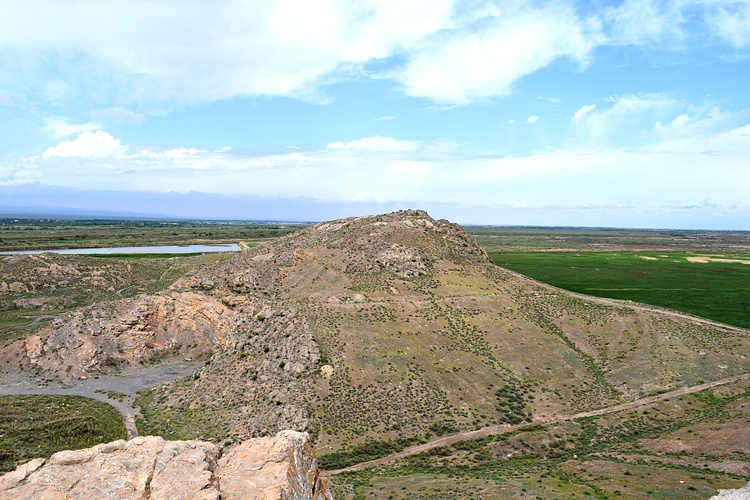
Artashat (aka Artaxata) was the capital of Ancient Armenia from 176 BCE and remained so for over 300 years of the kingdom's history. Located just south of Armenia's modern capital Yerevan, according to the ancient historian Plutarch, the city ’s original fortifications were planned by the Carthaginian general Hannibal. The city would need all the defences it could muster as it was attacked multiple times by Roman armies throughout its history until it was eventually replaced by Vagharshapat and Dvin as the country's first city.
FOUNDATION BY ARTAXIAS I
Around 200 BCE Artaxias I (aka Artashes or Artaxerxes), backed by the Seleucid ruler Antiochus III (r. 222-187 BCE), was made the Seleucid Empire ’s satrap in Armenia. Artaxias would reign until 165 or 160 BCE and found the Artaxiad dynastywhich would rule Armenia until the first decade of the 1st century CE.
ASIDE FROM THE PRESTIGE OF BUILDING A NEW CITY, ARTAXIAS WAS MOTIVATED BY THE CITY'S POSITION TO EXPLOIT REGIONAL TRADE.
In 176 BCE Artaxias founded his new capital of Artashat on a peninsula of nine hills along the Aras (Araxes) river. Ideal for defence, it was surrounded by water on three sides and further protected by the nearby promontory of Khor Virap (which was the site of an infamous prison and then monastery from the 3rd century CE). Aside from the prestige of building a brand new city, Artaxias was also motivated by the city's position to exploit regional trade, much better than the previous capital cities of Armavir and Yervandashat. The proximity to local forests and quarries provided all the building material required for the new capital.
Hannibal, the great Carthaginian general, who was then escaping the Romans after his defeat at the Battle of Zama in 202 BCE which ended the Second Punic War, was said to have designed the city's fortifications for Artaxias who then used the plans to build his city. The Greek historian Plutarch (c. 45 - c. 125 CE) gives the following version of events:
It is said that Hannibal the Carthaginian, after Antiochus had been conquered by the Romans, left him and went to Artaxias the Armenian, to whom he gave many excellent suggestions and instructions. For instance, observing that a section of the country which had the greatest natural advantages and attractions was lying idle and neglected, he drew up a plan for a city there, and then brought Artaxias to the place and showed him its possibilities, and urged him to undertake the building. The king was delighted, and begged Hannibal to superintend the work himself, whereupon a very great and beautiful city arose there, which was named after the king, and proclaimed the capital of Armenia. ( Life of Lucullus, Ch. 31)
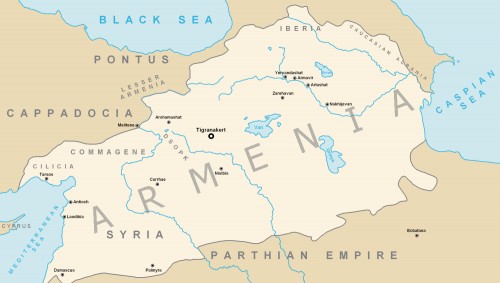
Tigranes the Great's Armenian Empire
Artashat was the first Armenian city to be built according to Hellenistic planning, and it eventually became the largest city yet built on the Plain of Ararat. The city's fine features are listed here by the historian RG Hovannisian:
The city contained a citadel on the height later called Xor Virap (Khor Virap) and was protected by extensive fortifications and a moat. Recent excavations have a revealed a major urban center with paved streets, public buildings, baths, shops, and workshops of various craftsmen…it rapidly became a major junction point between the trade route along the valley of the Araxes leading outward to Bactriaand India and the one running northward to the Black Sea. (49)
Artaxias was said to have adorned the city with fine bronze statues of Greek gods such as Zeus, Artemis, Apollo, and Hercules. The city's Greek and Persian cultural mix is attested by archaeological finds of Greek figurines and clay plaques with depictions of Iranian horse riders.
MITHRIDATIC WARS
Artashat was replaced as the Armenian capital when king Tigranes the Great (rc 95 - c. 56 BCE) founded the new and more centrally located city of Tigranocerta (Tigranakert) in 83 BCE. Artashat regained its former status when a Roman army under the command of Licinius Lucullus sacked Tigranocerta in 69 BCE as part of a campaign to finally capture Rome ’s enemy no.1: Mithridates VI of Pontus (r. 120-63 BCE), who went into hiding at Tigranes' capital, who was his son-in-law. When another army, this time led by Pompey the Great, attacked Armenia shortly after in 66 BCE, Artashat was besieged, but Tigranes capitulated, probably saving the city from destruction.

Map Roman-Parthian War, 58-60 CE
ROMAN-PARTHIAN WAR 58-63 CE
Between 58 and 60 CE, yet another Roman commander attacked the Armenian capital, this time Gnaeus Domitius Corbulo during the Roman-Parthian war of 58 to 63 CE. Such was Corbulo's reputation for taking and destroying forts and settlements that the inhabitants of Artashat opened the city gates and surrendered without a fight in 58 CE. It is also worth noting that the commander first let the non-combatants flee the city before he torched it, as here described by the Roman historian Tacitus (c. 56 - c. 120 CE):
[Corbulo] waited for daylight, and then sent on his light-armed troops, which were meanwhile to hover around the walls and begin the attack from a distance. The inhabitants, however, opened the gates of their own accord and surrendered themselves and their property to the Romans. This saved their lives; the city was fired, demolished and levelled to the ground, as it could not be held without a strong garrison from the extent of the walls, and we had not sufficient force to be divided between adequately garrisoning it and carrying on the war. If again the place were left untouched and unguarded, no advantage or glory would accrue from its capture. ( Annals, Ch. 13:41)
The war finally ended with the 63 CE Treaty of Rhandia in which it was agreed that Parthia had the right to nominate Armenian kings, Rome the right to crown them, and both powers would rule equally over Armenia with the king as their representative. Once the new king Tiridates I (r. 63 to 75 or 88 CE) was crowned by Roman emperor Nero in 66 CE, Artashat was rebuilt and, according to Roman writers, renamed Neronia.
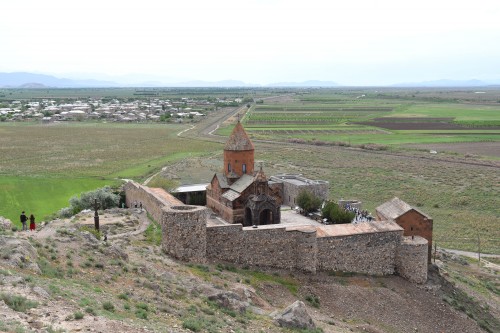
Armenia's Khor Virap Monastery
LATER HISTORY
Roman emperor Trajan (r. 98-117 CE) stationed two army divisions in Armenia and built a fort at Artashat to ensure Armenia stayed a Roman province and did not become absorbed into the Persian empire. A lengthy stone inscription in Latin survives from this period and list the various honorary titles of the Roman emperor.
Artashat was sacked again by the Romans (led by Avidius Cassius and Statius Priscus) in 166 CE before both Rome and Persia agreed the city was to become one of the official trading points between their two empires. As a consequence, the city thrived thereafter, even if it was replaced as the royal residence by Vagharshapat and sacked by Shapur II (r. 309-379 CE) of the Sasanian Empire in 368 CE. The city was by then eclipsed in importance by Dvin (Duin). Still, Artashat's continued prosperity is evidenced by an edict of 562 CE which confirmed the city as one of only three official trading points between the Byzantine and Persian Empires. A customs post there was overseen by officials known as “commercial counts” or comitescommercium.
Even into the period of Arab rule from the 7th century CE, the city was still a prosperous trade centre and became famous for its red cochineal dye known as kirmiz, which was especially important in the carpet industry and textiles in general. Artashat's ultimate abandonment in the late medieval period was probably due to flooding from the Aras River.
This article was made possible with generous support from the National Association for Armenian Studies and Researchand the Knights of Vartan Fund for Armenian Studies.
Roman Empire › Origins
Definition and Origins
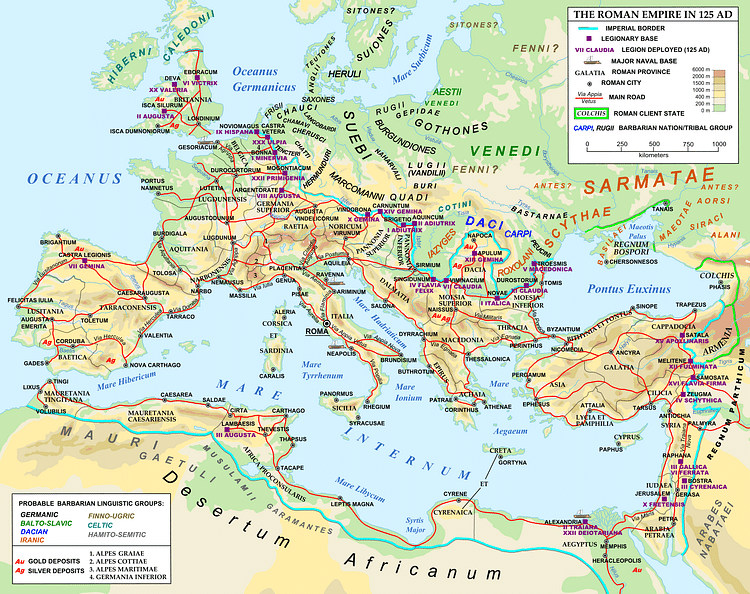
The Roman Empire, at its height (c. 117 CE), was the most extensive political and social structure in western civilization. By 285 CE the empire had grown too vast to be ruled from the central government at Rome and so was divided by Emperor Diocletian (284-305 CE) into a Western and an Eastern Empire. The Roman Empire began when Augustus Caesar (27 BCE-14 CE) became the first emperor of Rome and ended, in the west, when the last Roman emperor, Romulus Augustulus, was deposed by the Germanic King Odoacer (476 CE). In the east, it continued as the Byzantine Empire until the death of Constantine XI and the fall of Constantinople to the Ottoman Turks in 1453 CE. The influence of the Roman Empire on western civilization was profound in its lasting contributions to virtually every aspect of western culture.
THE EARLY DYNASTIES
Following the Battle of Actium in 31 BCE, Gaius Octavian Thurinus, Julius Caesar 's nephew and heir, became the first emperor of Rome and took the name Augustus Caesar. Although Julius Caesar is often regarded as the first emperor of Rome, this is incorrect; he never held the title `Emperor' but, rather, `Dictator', a title the Senate could not help but grant him, as Caesar held supreme military and political power at the time. In contrast, the Senate willingly granted Augustus the title of emperor, lavishing praise and power on him because he had destroyed Rome's enemies and brought much-needed stability.
AUGUSTUS: "I FOUND ROME A CITY OF CLAY BUT LEFT IT A CITY OF MARBLE."
Augustus ruled the empire from 31 BCE until 14 CE when he died. In that time, as he said himself, he "found Rome a city of clay but left it a city of marble." Augustus reformed the laws of the city and, by extension, the empire's, secured Rome's borders, initiated vast building projects (carried out largely by his faithful general Agrippa, who built the first Pantheon ), and secured the empire a lasting name as one of the greatest, if not the greatest, political and cultural powers in history. The Pax Romana (Roman Peace), also known as the Pax Augusta, which he initiated, was a time of peace and prosperity hitherto unknown and would last over 200 years.
Following Augustus' death, power passed to his heir, Tiberius, who continued many of the emperor's policies but lacked the strength of character and vision which so defined Augustus. This trend would continue, more or less steadily, with the emperors who followed: Caligula, Claudius, and Nero. These first five rulers of the empire are referred to as the Julio-Claudian Dynasty for the two family names they descended from (either by birth or through adoption), Julius and Claudius.Although Caligula has become notorious for his depravity and apparent insanity, his early rule was commendable as was that of his successor, Claudius, who expanded Rome's power and territory in Britain ; less so was that of Nero. Caligula and Claudius were both assassinated in office (Caligula by his Praetorian Guard and Claudius, apparently, by his wife). Nero's suicide ended the Julio-Claudian Dynasty and initiated the period of social unrest known as The Year of the Four Emperors.

Empreror Claudius or Nero
These four rulers were Galba, Otho, Vitellius, and Vespasian. Following Nero's suicide in 68 CE, Galba assumed rule (69 CE) and almost instantly proved unfit for the responsibility. He was assassinated by the Praetorian Guard. Otho succeeded him swiftly on the very day of his death, and ancient records indicate he was expected to make a good emperor. General Vitellius, however, sought power for himself and so initiated the brief civil war which ended in Otho's suicide and Vitellius' ascent to the throne.
Vitellius proved no more fit to rule than Galba had been, as he almost instantly engaged in luxurious entertainments and feasts at the expense of his duties. The legions declared for General Vespasian as emperor and marched on Rome. Vitellius was murdered by Vespasian's men, and Vespasian took power exactly one year from the day Galba had first ascended to the throne.
Vespasian founded the Flavian Dynasty which was characterized by massive building projects, economic prosperity, and expansion of the empire. Vespasian ruled from 69-79 CE, and in that time, initiated the building of the Flavian Amphitheatre(the famous Coliseum of Rome) which his son Titus (ruled 79-81 CE) would complete. Titus' early reign saw the eruption of Mount Vesuvius in 79 CE which buried the cities of Pompeii and Herculaneum.
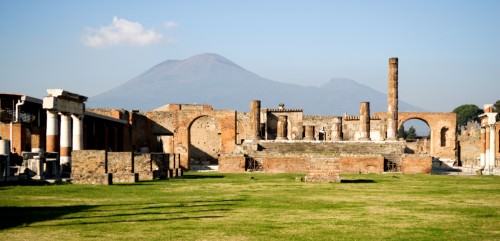
Pompeii and Mt. Vesuivus
Ancient sources are universal in their praise for his handling of this disaster as well as the great fire of Rome in 80 CE. Titus died of a fever in 81 CE and was succeeded by his brother Domitian who ruled from 81-96 CE. Domitian expanded and secured the boundaries of Rome, repaired the damage to the city caused by the great fire, continued the building projects initiated by his brother, and improved the economy of the empire. Even so, his autocratic methods and policies made him unpopular with the Roman Senate, and he was assassinated in 96 CE.
THE FIVE GOOD EMPERORS
Domitian's successor was his advisor Nerva who founded the Nervan-Antonin Dynasty which ruled Rome 96-192 CE. This period is marked by increased prosperity owing to the rulers known as The Five Good Emperors of Rome. Between 96 and 180 CE, five exceptional men ruled in sequence and brought the Roman Empire to its height:
- Nerva (96-98 CE)
- Trajan (98-117 CE)
- Hadrian (117-138 CE)
- Antoninus Pius (138-161 CE)
- Marcus Aurelius (161-180 CE)
Under their leadership, the Roman Empire grew stronger, more stable, and expanded in size and scope. Lucius Verus and Commodus are the last two of the Nervan-Antonin Dynasty. Verus was co-emperor with Marcus Aurelius until his death in 169 CE and seems to have been fairly ineffective. Commodus, Aurelius' son and successor, was one of the most disgraceful emperors Rome ever saw and is universally depicted as indulging himself and his whims at the expense of the empire. He was strangled by his wrestling partner in his bath in 192 CE, ending the Nervan-Antonin Dynasty and raising the prefect Pertinax(who most likely engineered Commodus' assassination) to power.
THE SEVERAN DYNASTY
Pertinax governed for only three months before he was assassinated. He was followed, in rapid succession, by four others in the period known as The Year of the Five Emperors, which culminated in the rise of Septimus Severus to power. Severus ruled Rome from 193-211 CE, founded the Severan Dynasty, defeated the Parthians, and expanded the empire. His campaigns in Africa and Britain were extensive and costly and would contribute to Rome's later financial difficulties. He was succeeded by his sons Caracalla and Geta, until Caracalla had his brother murdered.

Roman Beach Attack
Caracalla ruled until 217 CE, when he was assassinated by his bodyguard. It was under Caracalla's reign that Roman citizenship was expanded to include all free men within the empire. This law was said to have been enacted as a means of raising tax revenue, simply because, after its passage, there were more people the central government could tax. The Severan Dynasty continued, largely under the guidance and manipulation of Julia Maesa (referred to as `empress'), until the assassination of Alexander Severus in 235 CE which plunged the empire into the chaos known as The Crisis of the Third Century (lasting from 235-284 CE).
TWO EMPIRES: EAST & WEST
This period, also known as The Imperial Crisis, was characterized by constant civil war, as various military leaders fought for control of the empire. The crisis has been further noted by historians for widespread social unrest, economic instability (fostered, in part, by the devaluation of Roman currency by the Severans), and, finally, the dissolution of the empire which broke into three separate regions. The empire was reunited by Aurelian (270-275 CE) whose policies were further developed and improved upon by Diocletian who established the Tetrarchy (the rule of four) to maintain order throughout the empire.
THE IMPERIAL CRISIS WAS CHARACTERIZED BY CONSTANT CIVIL WAR, AS VARIOUS MILITARY LEADERS FOUGHT FOR CONTROL OF THE EMPIRE.
Even so, the empire was still so vast that Diocletian divided it in half in 285 CE to facilitate more efficient administration. In so doing, he created the Western Roman Empire and the Eastern Roman Empire (also known as the Byzantine Empire). Since a leading cause of the Imperial Crisis was a lack of clarity in succession, Diocletian decreed that successors must be chosen and approved from the outset of an individual's rule. Two of these successors were the generals Maxentius and Constantine.Diocletian voluntarily retired from rule in 305 CE, and the tetrarchy dissolved as rival regions of the empire vied with each other for dominance. Following Diocletian's death in 311 CE, Maxentius and Constantine plunged the empire again into civil war.
CONSTANTINE & CHRISTIANITY
In 312 CE Constantine defeated Maxentius at the Battle of the Milvian Bridge and became sole emperor of both the Western and Eastern Empires (ruling from 306-337 CE). Believing that Jesus Christ was responsible for his victory, Constantine initiated a series of laws such as the Edict of Milan (317 CE) which mandated religious tolerance throughout the empire and, specifically, tolerance for the faith which came to known as Christianity.

The Colossus of Constantine
In the same way that earlier Roman emperors had claimed a special relationship with a deity to augment their authority and standing (Caracalla with Serapis, for example, or Diocletian with Jupiter ), Constantine chose the figure of Jesus Christ. At the First Council of Nicea (325 CE), he presided over the gathering to codify the faith and decide on important issues such as the divinity of Jesus and which manuscripts would be collected to form the book known today as The Bible. He stabilized the empire, revalued the currency, and reformed the military, as well as founding the city he called New Rome on the site of the former city of Byzantium (modern-day Istanbul) which came to be known as Constantinople.
He is known as Constantine the Great owing to later Christian writers who saw him as a mighty champion of their faith but, as has been noted by many historians, the honorific could as easily be attributed to his religious, cultural, and political reforms, as well as his skill in battle and his large-scale building projects. After his death, his sons inherited the empire and, fairly quickly, embarked on a series of conflicts with each other which threatened to undo all that Constantine had accomplished.
His three sons, Constantine II, Constantius II, and Constans divided the Roman Empire between them but soon fell to fighting over which of them deserved more. In these conflicts, Constantine II and Constans were killed. Constantius II died later after naming his cousin Julian his successor and heir. Emperor Julian ruled for only two years (361-363 CE) and, in that time, tried to return Rome to her former glory through a series of reforms aimed at increasing efficiency in government.
As a Neo-Platonic philosopher, Julian rejected Christianity and blamed the faith; and Constantine's adherence to it, for the decline of the empire. While officially proclaiming a policy of religious tolerance, Julian systematically removed Christians from influential government positions, banned the teaching and spread of the religion, and barred Christians from military service.His death, while on campaign against the Persians, ended the dynasty Constantine had begun. He was the last pagan emperor of Rome and came to be known as `Julian the Apostate' for his opposition to Christianity.

Byzantine Empire c. 460 CE
After the brief rule of Jovian, who re-established Christianity as the dominant faith of the empire and repealed Julian's various edicts, the responsibility of emperor fell to Theodosius I. Theodosius I (379-395 CE) took Constantine's and Jovian's religious reforms to their natural ends, outlawed pagan worship throughout the empire, closed the schools and universities, and converted pagan temples into Christian churches.
THE UNITY OF SOCIAL DUTIES & RELIGIOUS BELIEF WHICH PAGANISM PROVIDED WAS SEVERED BY THE INSTITUTION OF CHRISTIANITY.
It was during this time that Plato ’s famous Academy was closed by Theodosius' decree. Many of his reforms were unpopular with both the Roman aristocracy and the common people who held to the traditional values of pagan practice. The unity of social duties and religious belief which paganism provided was severed by the institution of a religion which removed the gods from the earth and human society and proclaimed only one God who ruled from the heavens. Theodosius I devoted so much effort to promoting Christianity that he seems to have neglected other duties as emperor and would be the last to rule both Eastern and Western Empires.
THE FALL OF THE ROMAN EMPIRE
From 376-382 CE, Rome fought a series of battles against invading Goths known today as the Gothic Wars. At the Battle of Adrianople, 9 August 378 CE, the Roman Emperor Valens was defeated, and historians mark this event as pivotal in the decline of the Western Roman Empire. Various theories have been suggested as to the cause of the empire's fall but, even today, there is no universal agreement on what those specific factors were. Edward Gibbon has famously argued in his The History of the Decline and Fall of the Roman Empire that Christianity played a pivotal role, in that the new religion undermined the social mores of the empire which paganism provided.
The theory that Christianity was a root cause in the empire's fall was debated long before Gibbon, however, as Orosiusargued Christianity's innocence in Rome's decline as early as 418 CE. Orosius claimed it was primarily paganism itself and pagan practices which brought about the fall of Rome. Other influences which have been noted range from the corruption of the governing elite to the ungovernable vastness of the empire to the growing strength of the Germanic tribes and their constant incursions into Rome. The Roman military could no longer safeguard the borders as efficiently as they once had nor could the government as easily collect taxes in the provinces. The arrival of the Visigoths in the empire in the third century CE and their subsequent rebellions has also been cited a contributing factor in the decline.

Invasions of the Roman Empire
The Western Roman Empire officially ended 4 September 476 CE, when Emperor Romulus Augustus was deposed by the Germanic King Odoacer (though some historians date the end as 480 CE with the death of Julius Nepos). The Eastern Roman Empire continued on as the Byzantine Empire until 1453 CE, and though known early on as simply `the Roman Empire', it did not much resemble that entity at all. The Western Roman Empire would become re-invented later as The Holy Roman Empire, but that construct, also, was far removed from the Roman Empire of antiquity and was an `empire' in name only.
LEGACY OF THE ROMAN EMPIRE
The inventions and innovations which were generated by the Roman Empire profoundly altered the lives of the ancient people and continue to be used in cultures around the world today. Advancements in the construction of roads and buildings, indoor plumbing, aqueducts, and even fast-drying cement were either invented or improved upon by the Romans. The calendar used in the West derives from the one created by Julius Caesar, and the names of the days of the week (in the romance languages) and months of the year also come from Rome.
Apartment complexes (known as `insula), public toilets, locks and keys, newspapers, even socks all were developed by the Romans as were shoes, a postal system (modeled after the Persians), cosmetics, the magnifying glass, and the concept of satire in literature. During the time of the empire, significant developments were also advanced in the fields of medicine, law, religion, government, and warfare. The Romans were adept at borrowing from, and improving upon, those inventions or concepts they found among the indigenous populace of the regions they conquered. It is therefore difficult to say what is an `original' Roman invention and what is an innovation on a pre-existing concept, technique, or tool. It can safely be said, however, that the Roman Empire left an enduring legacy which continues to affect the way in which people live even today.
The Early Christianization of Armenia › Origins
Ancient Civilizations
The Christianization of Armenia began with the work of Syrian apostles from the 1st century CE and was boosted in the early 4th century CE by such figures as Saint Gregory the Illuminator, who converted the Armenian king and spread the gospel message. A more complex process than legendary accounts portray, Armenia's adoption of Christianity was, nevertheless, a momentous chapter in the country's history, as the historian RG Hovannisian here explains:
The conversion of Armenia to Christianity was probably the most crucial step in its history. It turned Armenia sharply away from its Iranian past and stamped it for centuries with an intrinsic character as clear to the native population as to those outside its borders, who identified Armenia almost at once as the first state to adopt Christianity. (81)

Detail of a Cross from Surb Karapet Church
THE LEGEND: SAINT GREGORY THE ILLUMINATOR
The credit for establishing Christianity as the official religion of ancient Armenia is traditionally given to Saint Gregory the Illuminator or Enlightener (previously known as Grigor Lusavorich, c. 239 - c. 330 CE). Gregory is credited with converting king Tiridates the Great (rc 298 to c. 330 CE) to the new religion, formally establishing the Armenian Church, and spreading Christianity throughout his country. For these achievements, Saint Gregory has become the patron saint of Armenia.
Gregory was born in Cappadocia and raised as a Christian, attending there a Greek Christian school. On returning to Armenia, Gregory gained a position as a palace functionary at the court of the Armenian king at Vagharshapat. There he made a stance against the pagan religion of the period and refused to participate in its rites. The reigning monarch was Tiridates the Great, and he had the troublesome Gregory imprisoned, tortured, and thrown into the terrible Khor Virap prison at Artashat. Known as the “pit of oblivion”, nobody ever returned from Khor Virap.
TO GET THE BALL ROLLING, TIRIDATES GAVE SAINT GREGORY UP TO 15 PROVINCES WORTH OF TERRITORY TO ESTABLISH THE ARMENIAN CHURCH.
After a 13-year ordeal down in the pit, Gregory was given a miraculous lifeline by, of all people, Tiridates' sister Khosrovidukht.She had had a vision that Gregory was the only person who could save the king from his terrible illness (lycanthropy).Accordingly, Gregory was freed from Khor Virap, and naturally, besides trying to cure the king, he made his best efforts to convert him to Christianity. Tradition (and the Armenian Apostolic Church) records that Tiridates was indeed cured and converted to his new faith in 301 CE by Saint Gregory.
Gregory was then made the first bishop ( katholikos ) in Armenia's history c. 314 CE, and he set about formally establishing the Christian Church. To get the ball rolling, Tiridates gave Saint Gregory up to 15 provinces worth of territory to establish the Armenian Church. The old pagan temples were torn down, and the whole nation was obliged to embrace the new faith.Churches and monasteries sprang up everywhere, and the Armenian aristocracy quickly followed the royal family's example with many noble families converting to Christianity.

Saint Gregory the Illuminator
Saint Gregory, then, had state backing to spread the Gospel message, and it was a work continued by his descendants who inherited the role of first bishop of Armenia. Gregory used two powerful tools to spread the word: education and military power.Schools were established in which children of the existing pagan priestly class were prepared for the Christian priesthood.Meanwhile, military units were dispatched to destroy pagan temple sites and confiscate their vast riches, which were then used to fund Christian building projects. Naturally, many temple sites, along with several rich and semi-independent feudal principalities, resisted the new policy and these were put to the sword. Pagan traditions were never fully eradicated but they certainly became weakened by the removal of the temples and their economic resources. Still, many anti-Christian and pro-Persian aristocratic families persisted in resisting at least into the next century. Gregory, meanwhile, oversaw mass baptisms in the Euphrates River; bishops were then appointed from the noble clans ( nakharars ) and lower priests from the class of knights ( azats ) to guide the ever-growing flock of faithful.
THE HISTORY: A GRADUAL ADOPTION
That is the legend of how Armenia became a Christian state. Modern historians, though, prefer a more organic process of acceptance and conversion occurring in different places at different times. They also prefer the more secure date of around 314 CE of Armenian's official adoption of Christianity. This followed the Roman emperor Constantine I ’s Edict of Milan in 313 CE which legalised Christianity in the Roman Empire of which Armenia was a province. It seems probable that Christianity actually entered Armenia by two separate but more or less contemporary routes, thus explaining the conflicting accounts in ancient historical records.
Saint Gregory represented the transmission via Greek culture in the capital while in the provinces a greater influence came from Syria, especially via the Armenian communities in the cities of Mtsbin and Edessa in Mesopotamia. Edessa, in particular, following the work of the two apostles Thaddeus and Bartholomew, was a major centre of the faith. With a large Armenian population and the religion having there been established for over two centuries, it is probable that returning emigrants brought Christianity back with them. Indeed, both of the aforementioned apostles travelled to Armenia, as did many Assyrian priests such as Bardatsan (Bardaisan) of Edessa, and there set up schools which taught and preached the new faith.Another route into Armenia of Christian ideas was via the border regions of Bitlis (Baghesh) and Mush (Taron) to the west of Lake Van. Thus, the spread of the religion was much slower and more haphazard than in the traditional account.

Tiridates the Great
Historians also suggest that Tiridates the Great may well have adopted Christianity for more practical reasons than a change of faith based on his miraculous recovery of health. The end of the ancient pagan religion was a fine excuse to confiscate the old temple treasuries which were jealously guarded by a hereditary class of priests. The religion was also a useful point of distinction between Armenia and Sasanid Persia, who had been trying to spread Zoroastrianism in the country. Christianity, therefore, became a means to resist Iranian cultural imperialism.
THE ARMENIAN CHURCH BECAME AN INDEPENDENT INSTITUTION WITH NOBLE FAMILIES PROVIDING ITS KEY FIGURES & MONASTERIES ABLE TO ACHIEVE SELF-SUFFICIENCY.
At the same time, Rome, the other regional power seeking to control Armenia, saw the value in permitting the spread of Christianity as a means to maintain Armenia's independence from Persia. Finally, a monotheistic religion with the monarch as God's representative on earth might well instil greater loyalties from his nobles and people in general. As it turned out, the Armenian Church became an independent institution with noble families providing its key figures and monasteries able to achieve self-sufficiency through their own landed estates.
TWO CHRISTIANITIES
As we have seen Christianity entered Armenia and spread outwards via two principal routes, from the southern provinces northwards and from the capital outwards. To further complicate matters, there were also two variants of the faith, as here explained by the historian S. Payaslian:
The southern Armenian form of Christianity was oriented more toward the masses, espoused more democratic ecclesiastical principles and communal philosophy, and was therefore less amenable to rigid institutional hierarchy…but it was the western, Greco- Roman form of Christianity, which entered Armenia by way of Cappadocia, that superseded the southern church and established its ecclesiastical hegemony in Armenia. (35)
Saint Gregory, was, of course, an exponent of the western form of the faith.
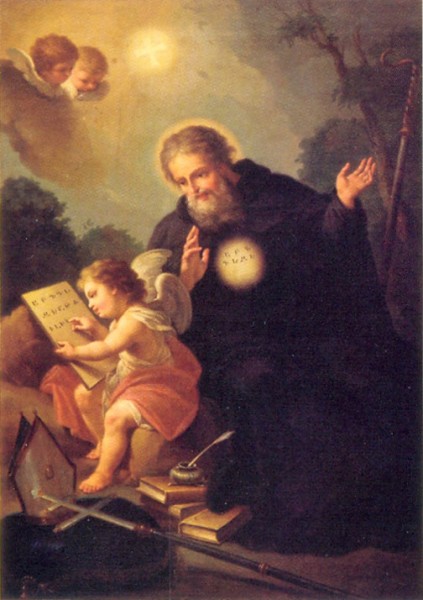
Mesrop Mashtots
SOCIAL CHANGES
For ordinary people, besides the obvious replacement of traditional gods and pagan temples, there were also social changes which directly affected them. One notable area was marriage as the Christian church formalised the institution and made it necessary for the couple to legalise their union through the swearing of vows which adhered to the Christian doctrine. Even the choice of partner was more limited as partners now had to come from outside one's family with the exception that a widow might marry her brother-in-law. Polygamy, which had not been uncommon, was also prohibited. Other traditional rituals which were now forbidden included lamentations for the dead and mourning dances during which mourners often cut their faces and arms. The Church brought benefits as well as restrictions, though, setting up hospitals, hostels, orphanages, and leprosaria for the poor and sick.
MESROP MASHTOTS & THE ARMENIAN ALPHABET
By the early 5th century CE Christianity in Armenia was given a great boost by the invention of the Armenian alphabet by the scholar-clergyman Mesrop Mashtots (360/370 - c. 440 CE). Mashtots, with full state and church backing, created a new scriptwith the primary purpose of allowing the common people to read the Bible and other Christian texts in their own spoken language, which at that time had no written form. The ultimate consequence of this approach to spreading the gospel through language is here summarised by S. Payaslian:
The following years witnessed enormous efforts by learned religious leaders and scholars to translate Greek and Syriac Christian texts into Armenian and to strengthen the new national culture through Armenianization. The church gradually gained control over Armenian culture, literature and education and, with the support of the state, instituted a Christian hegemonic, “totalising discourse”. Armenian culture, identity, and history came to be viewed nearly exclusively through the prism of Christian theology. (40)
This article was made possible with generous support from the National Association for Armenian Studies and Researchand the Knights of Vartan Fund for Armenian Studies.
LICENSE
Article based on information obtained from these sources:with permission from the Website Ancient History Encyclopedia
Content is available under License Creative Commons: Attribution-NonCommercial-ShareAlike 3.0 Unported. CC-BY-NC-SA License